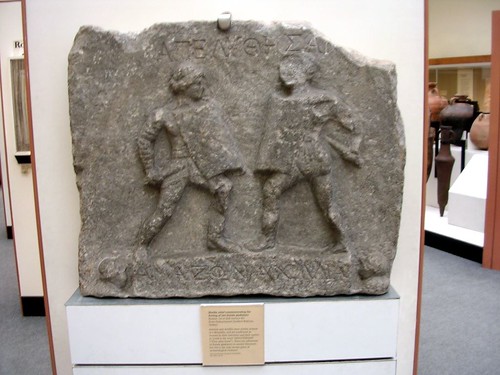 With all the buzz going on about the Ancient World in London Bloggers’ Challenge 2 competition, Ithought I’d weigh in with my own favourite ancient site in London – the grave of the Female Gladiator in Southwark.
With all the buzz going on about the Ancient World in London Bloggers’ Challenge 2 competition, Ithought I’d weigh in with my own favourite ancient site in London – the grave of the Female Gladiator in Southwark.
Now, admittedly, this is a classic case of the experience of the ancient world involving standing in front of one of those blue ceramic plaques imagining what a wild find was made there, since there’s nothing else to see. However, this is pretty inspirational stuff. The site, at 159 Great Dover Street in Southwark, was excavated in 2000 by the British Museum.
The grave sparked some controversy and debate, because it seemed fairly clear from the contents that it was the grave of a great gladiator. And yet it was in Southwark which, I hate to break it to residents of that fine Borough, has never exactly been a salubrious part of the city.
It turns out that women were a rarity in the male world of gladiators – they would go top of the bill at the Colosseum as a special “treat”. So, typically, the female who works in a traditionally male job paid not only with her life (hazard of the job, fair enough) but with her “respectability”. Hence, the speculation is, she rose to greatness in the arenas of Europe, and was honored hugely, but, because she was “just” a woman and shouldn’t have been seen out in leather armour in front of the jeering masses, she was buried somewhere a little bit out of the spotlight.
Well, you can chew on the implications of all that as you take a walk over the Thames to the British Museum, where you can view a beautiful relief of two female gladiators fighting, located in Room 69. According to museum scholars, the relief was carved on the occasion of the missio (honourable release) of two women fighters, ‘Amazon’ and ‘Achilia’, who had probably earned their freedom by giving a series of outstanding performances. The carving constitutes one of the key pieces of evidence that, yes, women as well as men fought to the death in front of roaring Roman crowds. As the relief shows, they didn’t wear helmets – presumably to show clearly to the audience that they had long hair and girly features and really were women after all. Apparently, they also often fought by night, raising the dramatic effect to feverishness, no doubt. Stay tuned for the inevitable Hollywood interpretation, starring Angelina Jolie.